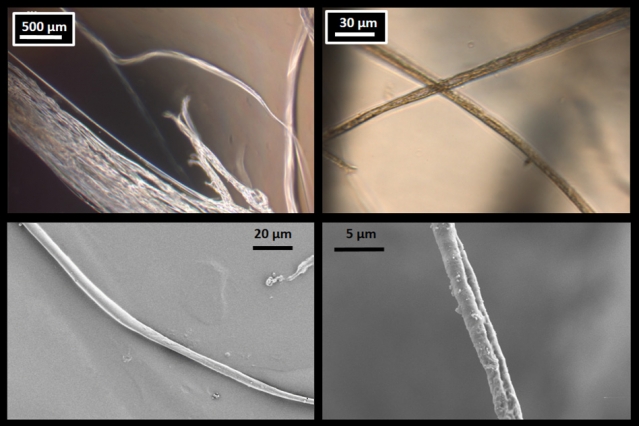May 29 2015
A team of researchers from various American universities has discovered a way to synthetically create spider silk samples in the laboratory after several years of studying the complex structure and production. This latest achievement could pave the way for numerous biomedical materials, ranging from sutures to scaffolding for organ replacements.
 Microscope images of lab-produced fibers confirm the results of the MIT researchers' simulations of spider silk. At top are optical microscope images, and, at bottom, are scanning electron microscope images. At left are fibers 8 micrometers across, and, at right, are thinner, 3 micrometer fibers. (Courtesy of the researchers)
Microscope images of lab-produced fibers confirm the results of the MIT researchers' simulations of spider silk. At top are optical microscope images, and, at bottom, are scanning electron microscope images. At left are fibers 8 micrometers across, and, at right, are thinner, 3 micrometer fibers. (Courtesy of the researchers)
The research findings were published in the journal Nature Communications by MIT professor of civil and environmental engineering (CEE) Markus Buehler, postdocs Shangchao Lin and Seunghwa Ryu, and others at MIT, Tufts University, Boston University, and in Germany, Italy, and the U.K.
The researchers used a number of simulations and experiments to create new fibers with characteristics better than those of natural silk, said Buehler, who is also the department head in CEE. He states that the project will enable the development of fibers with specific characteristics of strength, toughness and elasticity.
The proteins for this synthetic fiber were built by genetically altering bacteria to match the proteins normally produced by spiders. Microfluidic channels were designed to mimic the effect of a spinneret - the organ used by spiders for silk fiber production. The proteins were extruded through these channels to produce fibres.
Although the exceptional strength of spider silk has been known to researchers for years, it is not practical to breed spiders to produce harvestable fibers, and hence this latest research could introduce synthetic spider-like silk for use in biomedical applications for the first time.
Spider silks are naturally 100% biocompatible by nature, meaning that they can be used in the body without any harmful effects, and are eventually absorbed by the body.
A “spinning” method used by the researchers, wherein the basic proteins dissolved in water are extruded through a miniscule opening at a controlled rate, causes the molecules to become arranged in a manner that creates strong fibers.
As the molecules are a blend of hydrophobic and hydrophilic compounds, they naturally line up to form fibers which are a lot stronger than their constituent parts. “When you spin it, you create very strong bonds in one direction,” Buehler says.
The team also discovered that achieving the precise blend of proteins was critical.
“We found out that when there was a high proportion of hydrophobic proteins, it would not spin any fibers, it would just make an ugly mass,” says Ryu, who worked on the project as a postdoc at MIT and is now an assistant professor at the Korea Advanced Institute of Science and Technology. “We had to find the right mix” in order to produce strong fibers, he says.
This project is the first use of simulations to comprehend silk production at the molecular level. “Simulation is critical,” says Buehler. He explains that as synthesizing a protein can take many months, the entire process would be a waste if the protein does not possess the precise properties.
Using simulations makes it possible to “scan through a large range of proteins until we see changes in the fiber stiffness,” and then home in on those compounds, says Lin, who worked on the project as a postdoc at MIT and is now an assistant professor at Florida State University.
If the properties could be directly controlled, it could lead to the creation of synthetic fibers which are much stronger than the natural ones, as it would allow engineers to select characteristics to suit a specific use. For instance, spiders require their web to be elastic so as to trap insects without snapping, but synthetically designed fibers used as surgical sutures could be given strength rather than stretchiness. “Silk doesn’t give us that choice,” Buehler says.
It is possible to process the synthetic material at room temperature using water-based solutions, meaning it should be relatively easy to scale up manufacture. Currently, the lab-created synthetic fibers are not as strong as natural spider silk; however the researchers are hopeful that as the initial process has been established, it will be achievable to tweak the materials further to enhance its strength.
“Our goal is to improve the strength, elasticity, and toughness of artificially spun fibers by borrowing bright ideas from nature,” Lin says. This research is likely to encourage the development of novel synthetic fibers or any materials that need to have enhanced properties, such as in thermal and electrical transport.
“This is an amazing piece of work,” says Huajian Gao, a professor of engineering at Brown University who was not involved in this research. “This could lead to a breakthrough that may allow us to directly explore engineering applications of silk-like materials.”
Gao adds that the team’s exploration of variations in web structure “may have practical impacts in improving the design of fiber-reinforced composites by significantly increasing their strength and robustness without increasing the weight. The impact on material innovation could be particularly important for aerospace and industrial applications, where light weight is essential.”
The research was supported by the National Institutes of Health, the National Science Foundation, the Office of Naval Research, the National Research Foundation of Korea, and the European Research Council.